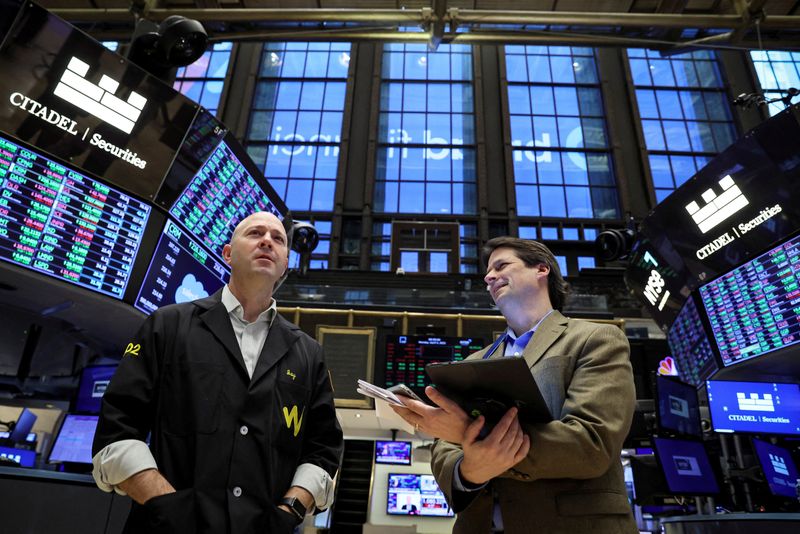Investing.com -- U.S. stock futures tick higher to begin a fresh trading week, with investors looking ahead to a key employment report later in the week that could influence on how Federal Reserve policymakers approach possible interest rate cuts this year. Meanwhile, Nvidia (NASDAQ:NVDA) unveils the latest generation of its crucial artificial intelligence chip as it attempts to address rising competition.
1. Futures higher
U.S. stock futures pointed higher on Monday, suggesting a positive start to a new month for equities after all three of the major indices on Wall Street clocked strong gains in May.
By 03:33 ET (07:34 GMT), the Dow futures contract had added 44 points or 0.1%, S&P 500 futures had inched up by 7 points or 0.1%, and Nasdaq 100 futures had risen by 43 points or 0.2%.
The blue-chip Dow Jones Industrial Average and benchmark S&P 500 both ended the final session of the previous month in the green, while the tech-heavy Nasdaq Composite closed marginally lower. The Dow climbed by 2.4%, the S&P 500 moved up by 4.8%, and the Nasdaq advanced by 6.9% in May.
On Friday, traders were assessing mixed signals from data that suggested some stickiness in inflationary pressures but weakening consumer spending activity. Investors are now placing roughly even odds on a potential Fed interest rate cut in September. Wagers of a second possible reduction in December were also bolstered.
2. U.S. jobs report ahead this week
Friday's closely-watched nonfarm payrolls report is expected to show that the U.S. labor market remained resilient in the face of elevated interest rates in May.
Economists are expecting the economy to have added 185,000 jobs during the month, a modest uptick from April.
Markets have been worried that an overly strong economy might prevent the Fed from lowering rates this year at all, or even require a rise in borrowing costs. But those concerns were somewhat alleviated last month, albeit temporarily, by data showing slowing in inflation and a cooling in job demand.
Policymakers have continued to call for patience on rate cuts, saying they would like to see more proof that inflation is sustainably heading back down to their 2% target. On Monday, Minneapolis Fed President Neel Kashkari echoed this sentiment, telling the Financial Times that rates may have to stay on hold for an "extended" period of time.
However, a soft employment report could hint at an easing in the broader economy -- a trend that may relieve some upward pressure on prices.
3. Nvidia unveils latest chip model
Nvidia has announced its newest line of artificial intelligence-optimized chips, as the semiconductor giant at the center of a boom in enthusiasm around AI looks to maintain a "one-year" cadence of fresh releases to combat intensifying competition.
In an unexpected move over the weekend, California-based Nvidia revealed its latest chip architecture, calling it "Rubin." Slated to begin shipping in 2026, Rubin's unveiling comes before the company's next generation of data center processors -- dubbed "Blackwell" -- has even started to be rolled out.
Blackwell itself is being produced only a little over a year after Nvidia's current "Hopper" chips were announced.
Nvidia, which has added around $350 billion in market value since it reported yet another quarter of bumper revenue last month, is racing to address competition from rivals Advanced Micro Devices (NASDAQ:AMD) and Intel (NASDAQ:INTC), as well as in-house chips made by tech giants like Google-owner Alphabet (NASDAQ:GOOGL) and software titan Microsoft (NASDAQ:MSFT).
Elsewhere on Sunday, AMD also unveiled an update for its own AI flagship AI chip, the MI325X accelerator, along with an upcoming series of its MI350 processor that will be available in 2025.
4. China manufacturing activity grows more than expected in May - Caixin PMI
China’s manufacturing sector grew more than expected in May, private purchasing managers' index data showed on Monday, indicating momentum in some sectors of the world’s second-biggest economy.
The Caixin manufacturing PMI read 51.7 for May, more than expectations of 51.6 and higher than the 51.4 in the prior month.
The figure largely contrasted with an official PMI reading from Friday, which showed that China’s manufacturing unexpectedly shrank in May.
But the Caixin PMI differs from the official data. The Caixin survey covers smaller, private businesses in southern China, while the official survey focuses more on larger, state-run businesses in the north.
The Caixin PMI also covers a smaller pool of Chinese businesses than the official reading. Investors usually use both surveys to get a broader picture of the Chinese economy.
5. Oil inches higher after OPEC+ extends production cuts
Oil prices ticked slightly higher in European trade on Monday after OPEC+ extended its current run of production cuts into next year, a decision that was widely expected by markets.
Brent oil futures expiring in August rose 0.1% to $81.21 a barrel, while West Texas Intermediate crude futures edged up 0.1% to $76.82 per barrel by 03:36 ET. Both contracts fell between 0.6% and 1% last week, weighed down in part by concerns that higher-for-longer interest rates could dent demand in the U.S., the world's top oil consumer.
The Organization of the Petroleum Exporting Countries and its allies including Russia, known as OPEC+, decided to extend its ongoing output cuts of roughly 5.86 million barrels per day well into 2025.
Specifically, it will maintain 3.6 million bpd of reductions until end-2025. Meanwhile, 2.2 million bpd of cuts will be prolonged by three months until the end of September this year and will then be gradually phased out from October until September 2025.
